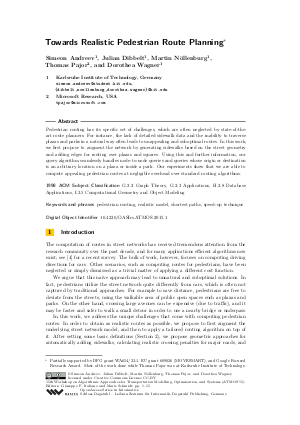Towards Realistic Pedestrian Route Planning
Authors Simeon Andreev, Julian Dibbelt, Martin Nöllenburg, Thomas Pajor, Dorothea Wagner
-
Part of:
Volume:
15th Workshop on Algorithmic Approaches for Transportation Modelling, Optimization, and Systems (ATMOS 2015)
Part of: Series: Open Access Series in Informatics (OASIcs)
Part of: Conference: Symposium on Algorithmic Approaches for Transportation Modelling, Optimization, and Systems (ATMOS) - License:
 Creative Commons Attribution 3.0 Unported license
Creative Commons Attribution 3.0 Unported license
- Publication Date: 2015-09-14
File

PDF
OASIcs.ATMOS.2015.1.pdf
- Filesize: 1.88 MB
- 15 pages
Document Identifiers
Subject Classification
Keywords
- pedestrian routing
- realistic model
- shortest paths
- speed-up technique
Metrics
- Access Statistics
-
Total Accesses (updated on a weekly basis)
0PDF Downloads0Metadata Views
Abstract
Pedestrian routing has its specific set of challenges, which are often neglected by state-of-the-art route planners. For instance, the lack of detailed sidewalk data and the inability to traverse plazas and parks in a natural way often leads to unappealing and suboptimal routes. In this work, we first propose to augment the network by generating sidewalks based on the street geometry and adding edges for routing over plazas and squares. Using this and further information, our query algorithm seamlessly handles node-to-node queries and queries whose origin or destination is an arbitrary location on a plaza or inside a park. Our experiments show that we are able to compute appealing pedestrian routes at negligible overhead over standard routing algorithms.
Cite As Get BibTex
Simeon Andreev, Julian Dibbelt, Martin Nöllenburg, Thomas Pajor, and Dorothea Wagner. Towards Realistic Pedestrian Route Planning. In 15th Workshop on Algorithmic Approaches for Transportation Modelling, Optimization, and Systems (ATMOS 2015). Open Access Series in Informatics (OASIcs), Volume 48, pp. 1-15, Schloss Dagstuhl – Leibniz-Zentrum für Informatik (2015)
https://doi.org/10.4230/OASIcs.ATMOS.2015.1
BibTex
@InProceedings{andreev_et_al:OASIcs.ATMOS.2015.1,
author = {Andreev, Simeon and Dibbelt, Julian and N\"{o}llenburg, Martin and Pajor, Thomas and Wagner, Dorothea},
title = {{Towards Realistic Pedestrian Route Planning}},
booktitle = {15th Workshop on Algorithmic Approaches for Transportation Modelling, Optimization, and Systems (ATMOS 2015)},
pages = {1--15},
series = {Open Access Series in Informatics (OASIcs)},
ISBN = {978-3-939897-99-6},
ISSN = {2190-6807},
year = {2015},
volume = {48},
editor = {Italiano, Giuseppe F. and Schmidt, Marie},
publisher = {Schloss Dagstuhl -- Leibniz-Zentrum f{\"u}r Informatik},
address = {Dagstuhl, Germany},
URL = {https://drops.dagstuhl.de/entities/document/10.4230/OASIcs.ATMOS.2015.1},
URN = {urn:nbn:de:0030-drops-54592},
doi = {10.4230/OASIcs.ATMOS.2015.1},
annote = {Keywords: pedestrian routing, realistic model, shortest paths, speed-up technique}
}
Author Details
References
-
H. Alt and E. Welzl. Visibility Graphs and Obstacle-avoiding Shortest Paths. Zeitschrift für Operations Research, 32(3-4):145-164, 1988.

-
Simeon Danailov Andreev. Realistic Pedestrian Routing. Bachelor thesis, Karlsruhe Institute of Technology, November 2012.

-
Miquel Ginard Ballester, Maurici Ruiz Pérez, and John Stuiver. Automatic Pedestrian Network Generation. In Proceedings 14th AGILE International Conference on GIS, pages 1-13, 2011.

-
Hannah Bast, Daniel Delling, Andrew V. Goldberg, Matthias Müller-Hannemann, Thomas Pajor, Peter Sanders, Dorothea Wagner, and Renato F. Werneck. Route Planning in Transportation Networks. Technical Report abs/1504.05140, ArXiv e-prints, 2015.

-
Jon Louis Bentley. Multidimensional Binary Search Trees Used for Associative Searching. Commun. ACM, 18(9):509-517, September 1975.

-
Raymond C. Browning, Emily A. Baker, Jessica A. Herron, and Rodger Kram. Effects of Obesity and Sex on the Energetic Cost and Preferred Speed of Walking. Journal of Applied Physiology, 100(2):390-398, 2006.

-
Francisc Bungiu, Michael Hemmer, John Hershberger, Kan Huang, and Alexander Kröller. Efficient Computation of Visibility Polygons. CoRR, abs/1403.3905, 2014.

-
Mark de Berg, Otfried Cheong, Marc van Kreveld, and Mark Overmars. Computational Geometry: Algorithms and Applications. Springer, 3rd edition, 2008.

-
Daniel Delling, Andrew V. Goldberg, Thomas Pajor, and Renato F. Werneck. Customizable Route Planning in Road Networks. Transportation Science, 2015.

-
Daniel Delling, Andrew V. Goldberg, Ilya Razenshteyn, and Renato F. Werneck. Graph Partitioning with Natural Cuts. In 25th International Parallel and Distributed Processing Symposium (IPDPS'11), pages 1135-1146. IEEE Computer Society, 2011.

-
Edsger W. Dijkstra. A Note on Two Problems in Connexion with Graphs. Numerische Mathematik, 1:269-271, 1959.

-
Hassan A. Karimi and Piyawan Kasemsuppakorn. Pedestrian Network Map Generation Approaches and Recommendation. International Journal of Geographical Information Science, 27(5):947-962, 2013.

-
Jean-Claude Latombe. Robot Motion Planning, volume 124 of Springer International Series in Engineering and Computer Science. Springer, 1991.

-
Ellips Masehian and M. R. Amin-Naseri. A Voronoi Diagram-visibility Graph-potential Field Compound Algorithm for Robot Path Planning. J. Robotic Systems, 21(6):275-300, 2004.

-
M. Mokhtarzade and M.J. Valadan Zoej. Road Detection from High-Resolution Satellite Images Using Artificial Neural Networks. International Journal of Applied Earth Observation and Geoinformation, 9(1):32-40, 2007.

-
M. H. Overmars and Emo Welzl. New Methods for Computing Visibility Graphs. In Proc. 4th Annu. ACM Sympos. Comput. Geom., pages 164-171, 1988.

-
Scott Parker and Ellen Vanderslice. Pedestrian Network Analysis. In Walk 21 IV, Portland, OR, 2003.

-
Ting Peng, Ian H. Jermyn, Veronique Prinet, and Josiane Zerubia. Extended Phase Field Higher-Order Active Contour Models for Networks. International Journal of Computer Vision, 88(1):111-128, 2010.

-
Peter Sanders and Dominik Schultes. Highway Hierarchies Hasten Exact Shortest Path Queries. In Proceedings of the 13th Annual European Symposium on Algorithms (ESA'05), volume 3669 of Lecture Notes in Computer Science, pages 568-579. Springer, 2005.

-
J.T. Schwartz and M. Sharir. A Survey of Motion Planning and Related Geometric Algorithms. Artificial Intelligence, 37(1–-3):157-169, 1988.

-
Sabine Storandt. Route Planning for Bicycles - Exact Constrained Shortest Paths Made Practical Via Contraction Hierarchy . In Proceedings of the Twenty-Second International Conference on Automated Planning and Scheduling, pages 234-242, 2012.

-
The CGAL Project. CGAL User and Reference Manual. CGAL Editorial Board, 4.6 edition, 2015.

